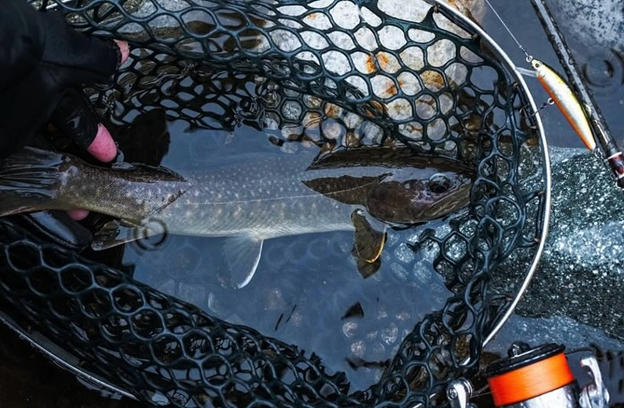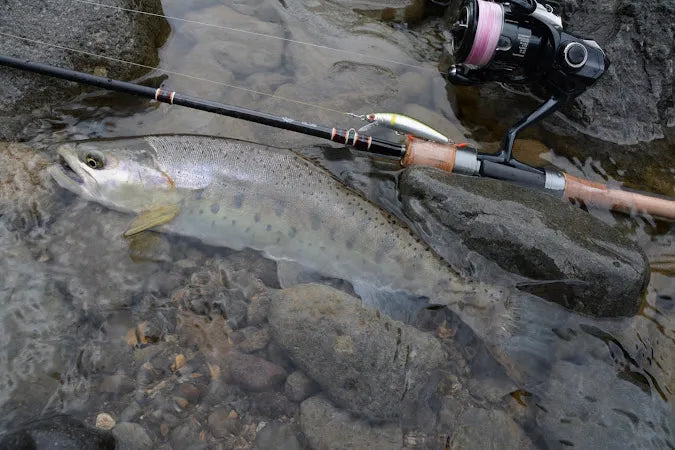
Choosing a Trout BFS Rod: Why BFS and Selection Criteria
Bait finesse fishing is a relatively new style of fishing that revolves around closely matching your BFS rod, reel, line and lures to a target species, often in a specific type of environment. It allows you to leverage greater control over casting, accuracy, and playing the fish, often while throwing very light lures.
It is an exciting discipline and will take your enjoyment of angling (as well as the challenge) to a new level.
But one of the first things you will need to do is pick out a bait finesse rod. Here are some notes for that.
How to Compare Trout BFS Rods

One of the most important factors that will influence your decision to purchase a BFS rod is target species - but that part is already covered for us since you are here for a trout rod.
With that squared away, here are some other types of considerations you should make:
-
Type of trout fishing lure and lure weight: What trout fishing lures you will be throwing will have a big impact on what sort of BFS rod you should choose, mostly because lure size, weight and fish size will impact castability. Keep in mind that trout spinners tend to be smaller and denser than most trout minnows, making them easier to cast, even with a shorter rod.
-
Rod length: Rod length is another very important factor to consider before your purchase of your first BFS rod for trout. As a general rule, shorter rods will offer greater controllability and precise presentation. Whereas longer rods offer greater casting distance because they are literally longer “levers.” Shorter rods also offer better overall usability in areas in which you will not have a lot of room for a backcast, such as in areas where there is a lot of brush around you.
-
Rod power and action: Rod power varies from ultralight to medium: power indicates how much the rod will bend in an arc when force is applied. Action refers to which section of the rod bends (regardless of power), or how much it bends across its profile. A rod can have either fast, moderate, or slow action. The lighter the power of the rod, the more fun and challenging it is to pursue large, trophy-sized trout. As for action, a faster action will provide greater sensitivity and control of lighter lures, whereas a more moderate action will prove more forgiving, especially on backhand casts with a casting reel.
-
Rod material: Most modern BFS rods are made of graphite, which is composed of carbon fiber. Graphite is ideal primarily because it is both lightweight (which reduces fatigue) and sensitive (which improves strike detection). There are also fiberglass rods, which are generally more durable, but which have more moderate actions to keep the fish pinned during fight but lack the sensitivity compared to the graphite.
-
Your choice of reel: Many anglers will pair their BFS rods with a casting reel, because casting reels provide quicker operation, accuracy, and control over the trout fishing lure as well as over the fish. Casting reels also generally have more robust drag systems, making them better for fighting bigger fish.
- Budget: Lastly, you have to make sure that you’re getting a BFS rod that meets your budget; as a general rule, castability is preferred over sensitivity, especially with trout minnows as the fish will generally hook themselves especially with the single barbless hooks. Therefore, all else being equal, a rod that offers better castability is better, especially for a beginner, than one that is more sensitive.
Why a BFS Rod for Trout in the First Place?

You might be thinking you can just skip the whole BFS trend and go right for an ultralight trout fishing pole, which will offer many of the same advantages as a BFS outfit. But the truth is, BFS rods for trout offer a unique subset of advantages when compared to ultralights - and not all bait finesse systems are ultralights anyway.
-
Precise control over the trout fishing lure: A true bait finesse system isn’t just about the rod and reel, but about the trout fishing lures you pair with it. Since these systems are inclusive of your terminal tackle, you’ll enjoy much greater control over your lure, not just when casting but when working it in the water, than you would with any other outfit.
-
Improved castability and accuracy: Another advantage of a trout BFS rod, and probably the biggest one, is that it will improve casting distance as well as accuracy. Wild trout are finicky, largely visual feeders, and are quite cautious, so they will stick like glue to structure. As a result, you often need to be very accurate with your lure placement - BFS systems excel at very accurate casts, even in tight quarters.
- Versatility in approaching challenging situations: Whether you are fishing a lake or a small stream, a BFS outfit can be tailored to meet the needs of the environment, so you can be successful on the water, no matter where you are.
Mastering the Bait Finesse System
Congratulations on taking the first step towards getting into bait finesse fishing, which is deciding you want to give it a try. But there is one more important thing you need to remember: it’s not just about the rod, or even the rod and reel, but the whole outfit.
Your rod and reel must be matched appropriately to each other, of course, but you also have to consider your line material and weight, as well as the trout fishing lures you choose to throw with them. Remember, this is a bait finesse system, it’s not just one or two pieces of gear.
By dialing in on appropriate trout fishing gear, you’ll enjoy more success on the water.
Explore Trout BFS Rods, Reels and Trout Fishing Lures
Interested in getting a trout BFS rod but aren’t sure where to start? We recommend a Trout Signal for beginners, and while you’re here, take a look through our collection of trout fishing lures to explore a wide range of unique patterns that are highly effective on wild trout.


